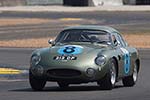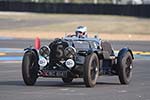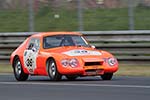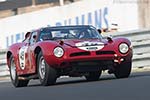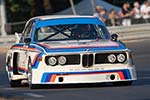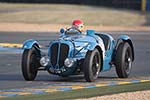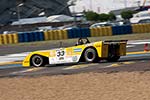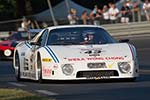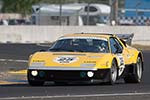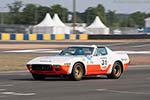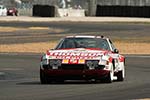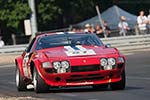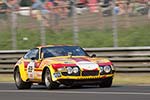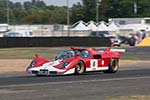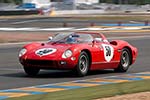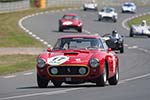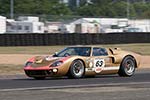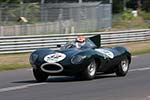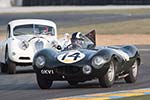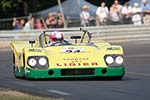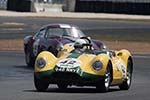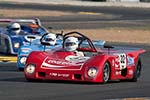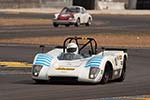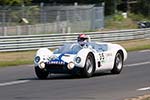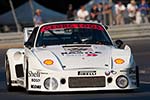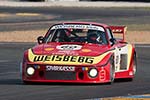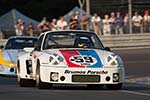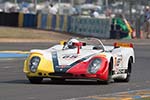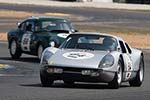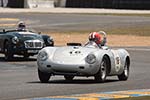Introduction

First held in 1923, the 24 Hours of Le Mans is one of the oldest and most famous motor races in the world. For most of its history, the event has been run on the semi-permanent track that includes the public roads that connect the city of Le Mans with the towns of Mulsanne and Arnage, and is used to this day. Until 2002 the roads were only closed off for the annual 24-hour race. That year the roster of events was expanded with the Le Mans Classic, which also uses the full 13.6 km version of the track. This opened the door for owners of historic sports car racers to get a taste of the high speed circuit. Spread over six 'grids', the event today welcomes machines of a type that raced at Le Mans between 1923 and 1980. For the fifth edition over 400 cars were entered and the entry list boasted both Le Mans winning cars and drivers. Complementing the action on the track, the Le Mans Classic also attracts hundreds of clubs representing specific manufacturers and even models. It is estimated that they provided over 7000 cars this year which were lined up along the Bugatti section of the circuit, which, of course, was not in use for the races. A new addition for 2010 was an auction organised by the Paris based Artcurial, who filled the void left by Coys (2002) and Christie's (2004 and 2006).
Under scorching conditions, our photographers were track-side for most of the weekend and have captured all six groups and the Artcurial auction in great detail. The 200 finest shots have made into our
exclusive gallery.
Inaugural Artcurial Motorcars auction
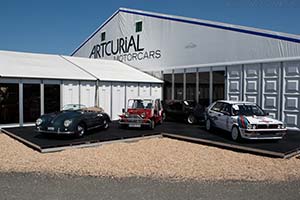
One of the big stories in the European auction world this Winter was the move to Artcurial of Matthieu Lamoure and his loyal assistant Pierre Novikoff from Bonhams, where they ran the European department. At Artcurial, they established a dedicated motoring department, which held its inaugural auction at this year's Le Mans Classic. Headlined by the McLaren F1 GTR 'art-car' that raced at Le Mans in 1995, the sale included around sixty lots. Interestingly the artwork on the McLaren and most of the earlier 'art-cars' was commissioned by Herve Poulain, who was one of Artcurial's founders and the auctioneer of this sale. The painting on the car's panels was the work of legendary French 'Pop-Artist' Cesar. He made the design on a model car and that was later transferred on the actual car by another painter. That same painter was commissioned to restore the car to its 1995 Le Mans livery ahead of the sale. Despite being very well publicised the unique F1 GTR did not attract enough interest to break the reserve set. That was certainly not the case with the Lamborghini Miura SV present; it sold for just over 680,000 Euro, which was well over its top estimate of 600,000 Euro. The highest price was paid for a fine four-cam Ferrari 275 GTB, which changed hands for a hefty 837,474 Euro. At the end of the day the inaugural Artcurial Motorcars sale grossed a very commendable 6,615,720 Euro.
The races

As mentioned earlier the field of cars was spread over six grids, divided by age. During the 4pm on Saturday and 4pm on Sunday, each grid was out three times for 45-minute races. The final result for each grid was formed by adding up the times of the three individual races. For each grid there was a scratch result for the fastest car outright and an indexed result in the spirit of the much coveted 'Index of Performance' award of old. Another tradition re-instated, at least for the first race (Grid 3), was the Le Mans style start. Fifteen minutes before the actual start, the drivers ran across the track to the cars. Although they would have to line up in the correct order behind the course car, many drivers took the run very seriously. The subsequent heats were all started behind the safety car after a single warm-up lap. Although entrants could opt to singlehandedly drive all three races, all cars were mandated to come into the pit once during each race. To allow for the drivers to be safely strapped into the cars, there was a 90 second minimum for the mandatory stop.
Grid 1: 1923 - 1939

From the very first edition, the 24 Hours of Le Mans had the interest of manufacturers. In 1923 a 'works' Chenard & Walcker took the very first win on a version of the circuit that ran all the way into the centre of the city. This year a 1923 vintage Chenard & Walcker was present but sadly it only ran in the practice sessions. A rare survivor of that inaugural Le Mans was the Ford Model T based Montier Special, which has become a Le Mans Classic regular and was raced this year with official backing of Ford France. A Bentley won the second edition and the British marque would win four more before the turn of the decade. After Bentley's withdrawal from racing the country's honour was defended by the works Talbots. They were particularly well represented this year with almost all surviving examples of the Le Mans entrants present in the race. Most of them have been raced throughout their lives and are among the quickest cars of the period. One of the Talbots was quickest in practice but eventually had to yield its lead in the race to Albert Otten in his slightly later BMW 328. The colourful Grid 1 consisted further of a host of Bugattis, MGs, Lagondas, Delahayes, Invictas, Aston Martins and an Alfa Romeo.
Grid 2: 1949 - 1956

During the 1940s the world was turned upside down at more than one occasion and in the end much progress was made. That is very well illustrated by the second grid, which features considerably more modern cars. Jaguar dominated this period with the XK120 based C-Type (2 wins) and bespoke D-Type (3 wins). Fittingly these six-cylinder engined machine also dominated this class in 2010. Those that were still asleep at 6am on Sunday morning missed a thrilling fight between historic racing aces Simon Hadfield and Gary Pearson in similar D-Types. The two were nose to tail for most of the second heat of this grid until Hadfield had a spin in the final lap, handing the lead to Pearson. In the end top honours were for the Peter Neumark and Simon Hope driven D-Type. Behind the big six-cylinder engined Jaguars, Fabrice Mestrot and Philippe Louet did enough to secure an indexed victory in their Triumph TR2. This result was determined by multiplying the final time with a pre-determined coefficient; 0.82 for the D-Type and 0.5 for the TR2. Coincidentally, Neumark and Hope finished 17th in the indexed classification, while Mestrot and Louet were classified 17th in the scratch results. Among the more unusual cars in this grid were a Jowett Jupiter, a Skoda 1101, a Fiat 1500 Speciale and a 750cc DB HBR 53, which was originally designed specifically to win the Index of Performance.
Grid 3: 1957 - 1961

Ferrari and to a lesser extent Aston Martin dominated this period but this year they did not star in this grid. Instead various versions of the very slippery Lotus sports cars and a very rare 'low drag' Maserati Tipo 61 'Birdcage' were found at the front of the field. Painted in the evocative 'Camoradi' colours, the Maserati was driven very well by former DTM racer Frank Stippler and its owner Willi Balz. They were most closely challenged by Joe Twyman and Roger Wills in a Lotus 15. After 27 laps, the difference between the two was less than 4 seconds in favour of the Maserati. A Lotus did top the indexed standings; the 1500 cc 'Eleven' driven by Rob Barff, Fergus Macleod and Neil Macleod. One of the absolute stars of this 'plateau' was Stefan Zieglers Jaguar E2A, which he co-drove with Robert Newall. Built in 1960, the unique E2A prototype forms the 'missing link' between the D-Type and the E-Type. It was entered in the 1960 24 Hours by Briggs Cunningham and has since survived in remarkably original condition. Two years ago it passed into the current ownership for a staggering $4.5 million, making it the most expensive Jaguar ever sold at auction. Another Jaguar of note was the D-Type brought by Nigel Webb, which is the very car that took the outright win back in 1955.
Grid 4: 1962 - 1965

Ferrari's dominance continued well into the 1960s with back-to-back victories until 1966. Several of these successful and highly valuable machines were present this year. The highlight was the 330 TRI/LM, which was driven to the outright victory in 1962; the last for a front-engined car. The following two years the mid-engined 250/275/330Ps seamlessly took over from the legendary Testa Rossas. One of these made a very rare appearance and was driven very well by Claudia Huertgen. She was able to challenge the top runners early on but mechanical problems dropped her out of contention. Even when the four-litre V12 was firing on all twelve cylinders, she was not able to challenge compatriot Christian Glaesel in his beautifully prepared Ford GT40. He took the outright victory with a gap of over 8 minutes to his closest rival. With a coefficient of 1.15, the GT40s played no part in the indexed standings. These were topped by John Emberson and William Wykeham in the Morgan +4 (0.75 coefficient).
Grid 5: 1966 - 1971

Although Fords took four victories in this period, it is best remembered for the epic fights between the Porsche 917s and Ferrari 512s. History repeated itself forty years later as one of the former and three of the latter lined up. Liveried in the legendary Gulf colours, the Porsche was driven by 1970 Le Mans winner Richard Attwood and 1983 Le Mans winner Vern Schuppan. All four were found in the top ten after the qualifying session but only the 917 managed to get through all three sessions without problems to finish third. The grid was dominated by Jacques Nicolet and Jean-Marc Luco until the final laps in the unique Ligier JS3. The nose of the yellow and green machine featured the text 'Hommage a Guy Ligier', who turned 80 the day after. Unfortunately mechanical problem in the final heat robbed him of a very special birthday present. This allowed Bernard Thuner to grab the lead after a strong drive in an earlier Lola T70 Mk III. Amidst all the big bangers, racing dentist John Sheldon finished a fabulous second in his 1600cc Chevron B16. Another entrant of note was August Deutsch' Porsche 908/2, which was raced by Steve McQueen to second in the Sebring 12 Hours and later used as a camera car in the 1971 Le Mans to shoot the motion picture Le Mans. It finished the race in 9th despite having to change reels several times. For the occasion it was restored to its camera car configuration and it was co-driven by David Piper, who lost his part of one of legs during the filming of the movie.
Grid 6: 1972 - 1979

In this era turbocharged engines took control of Le Mans powering both prototypes and GT racers to victory in the 24 Hours. The turbos provided both additional power and more spectacle with big flames from the exhausts. Particularly the various Porsche 935 versions provided the spectacle at this year's Le Mans Classic. Another turbocharged Porsche, the very rare ex-Joest 936, driven by Nicolet and Luco, headed the field throughout the race. This time the car did not let the French and Swiss drivers down and they were able to clinch the victory. One of the 935s few rivals, the Ferrari 512 BBLM, was also out in force with five examples on the entry list. Among them were both European University machines; one with the blue and yellow star livery and the other with the red yellow star livery. The field also featured a fabulous selection of smaller engined open prototypes from the likes of Lola, Chevron and Mirage. Also present was the unique Duckhams, which was designed by Gordon Murray for Alain de Cadennet. With three victories, Henri Pescarolo was the superstar of this decade. He returned to the track where he celebrated so many successes as driver, entrant and constructor behind the wheel of the 1976 Inaltera.
Final Thoughts
Despite the tropical conditions, nearly 96,000 spectators turned up for the 2010 Le Mans Classic. They were treated to spectacular racing and still lined the fences until the dying seconds of the final heat on Sunday. The unique location attracted more special cars than ever before. It was particularly fantastic to see some of the most expensive cars in the world, like the Ferrari 330 TRI/LM and Jaguar E2A, back at the track where they starred fifty years ago. Unfortunately we now have to wait two years for the sixth edition of this classic event.
|
|
|
|
| |
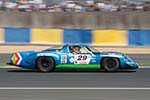
|
|
|
Alpine A220
|
101

|
| Produced in: |
1968 |
| Last updated: |
03 / 29 / 2016 |
|
|
|
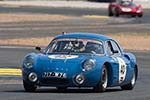
|
|
|
Alpine M63
|
32

|
| Produced in: |
1963 |
| Last updated: |
06 / 10 / 2013 |
|
|
| |
|
|
|
|
| |
|
|
|
|
| |
|
|
|
|
| |
|
|
|
|
| |
|
|
|
|
| |
|
|
|
|
| |
|
|
|
|
| |
|
|
|
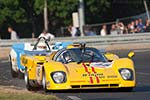
|
|
|
Ferrari 512 M
|
160

|
| Years of production: |
1970 - 1971 |
| Last updated: |
10 / 29 / 2010 |
|
|
| |
|
|
|
|
| |

|
|
|
Ferrari 250 LM
|
425

|
| Years of production: |
1963 - 1966 |
| Last updated: |
12 / 18 / 2015 |
|
|
|
|
| |
|
|
|
|
| |
|
|
|
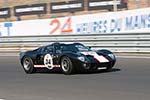
|
|
|
Ford GT40
|
393

|
| Years of production: |
1965 - 1969 |
| Last updated: |
12 / 07 / 2015 |
|
|
| |
|
|
|
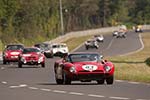
|
|
|
Iso Grifo A3/C
|
114

|
| Years of production: |
1963 - 1965 |
| Last updated: |
02 / 18 / 2013 |
|
|
| |
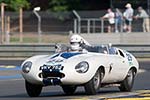
|
|
|
Jaguar E2A
|
28

|
| Produced in: |
1960 |
| Last updated: |
07 / 22 / 2010 |
|
|
|
|
| |
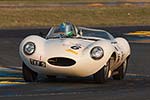
|
|
|
Jaguar D-Type
|
240

|
| Years of production: |
1955 - 1958 |
| Last updated: |
08 / 04 / 2016 |
|
|
|
|
| |
|
|
|
|
| |
|
|
|
|
| |
|
|
|
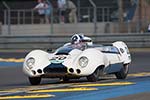
|
|
|
Lotus 15 Climax
|
212

|
| Years of production: |
1958 - 1960 |
| Last updated: |
09 / 29 / 2014 |
|
|
| |
|
|
|

|
|
|
Maserati 300S
|
482

|
| Years of production: |
1955 - 1958 |
| Last updated: |
11 / 10 / 2014 |
|
|
| |
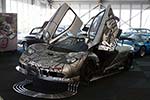
|
|
|
McLaren F1 GTR
|
208

|
| Years of production: |
1995 - 1996 |
| Last updated: |
02 / 20 / 2015 |
|
|
|
|
| |

|
|
|
Porsche 935 J
|
81

|
| Years of production: |
1979 - 1980 |
| Last updated: |
01 / 26 / 2018 |
|
|
|
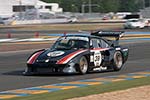
|
|
|
Porsche 935 K3
|
434

|
| Years of production: |
1979 - 1981 |
| Last updated: |
12 / 02 / 2015 |
|
|
| |
|
|
|
|
| |
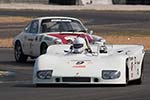
|
|
|
Porsche 908/03
|
165

|
| Years of production: |
1970 - 1971 |
| Last updated: |
02 / 28 / 2013 |
|
|
|
|
| |
|
|
|
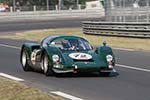
|
|
|
Porsche 906
|
135

|
| Produced in: |
1966 |
| Last updated: |
02 / 06 / 2006 |
|
|
| |
|
|
|
|
| |
|
|
|
|
| |

 First held in 1923, the 24 Hours of Le Mans is one of the oldest and most famous motor races in the world. For most of its history, the event has been run on the semi-permanent track that includes the public roads that connect the city of Le Mans with the towns of Mulsanne and Arnage, and is used to this day. Until 2002 the roads were only closed off for the annual 24-hour race. That year the roster of events was expanded with the Le Mans Classic, which also uses the full 13.6 km version of the track. This opened the door for owners of historic sports car racers to get a taste of the high speed circuit. Spread over six 'grids', the event today welcomes machines of a type that raced at Le Mans between 1923 and 1980. For the fifth edition over 400 cars were entered and the entry list boasted both Le Mans winning cars and drivers. Complementing the action on the track, the Le Mans Classic also attracts hundreds of clubs representing specific manufacturers and even models. It is estimated that they provided over 7000 cars this year which were lined up along the Bugatti section of the circuit, which, of course, was not in use for the races. A new addition for 2010 was an auction organised by the Paris based Artcurial, who filled the void left by Coys (2002) and Christie's (2004 and 2006).
First held in 1923, the 24 Hours of Le Mans is one of the oldest and most famous motor races in the world. For most of its history, the event has been run on the semi-permanent track that includes the public roads that connect the city of Le Mans with the towns of Mulsanne and Arnage, and is used to this day. Until 2002 the roads were only closed off for the annual 24-hour race. That year the roster of events was expanded with the Le Mans Classic, which also uses the full 13.6 km version of the track. This opened the door for owners of historic sports car racers to get a taste of the high speed circuit. Spread over six 'grids', the event today welcomes machines of a type that raced at Le Mans between 1923 and 1980. For the fifth edition over 400 cars were entered and the entry list boasted both Le Mans winning cars and drivers. Complementing the action on the track, the Le Mans Classic also attracts hundreds of clubs representing specific manufacturers and even models. It is estimated that they provided over 7000 cars this year which were lined up along the Bugatti section of the circuit, which, of course, was not in use for the races. A new addition for 2010 was an auction organised by the Paris based Artcurial, who filled the void left by Coys (2002) and Christie's (2004 and 2006). One of the big stories in the European auction world this Winter was the move to Artcurial of Matthieu Lamoure and his loyal assistant Pierre Novikoff from Bonhams, where they ran the European department. At Artcurial, they established a dedicated motoring department, which held its inaugural auction at this year's Le Mans Classic. Headlined by the McLaren F1 GTR 'art-car' that raced at Le Mans in 1995, the sale included around sixty lots. Interestingly the artwork on the McLaren and most of the earlier 'art-cars' was commissioned by Herve Poulain, who was one of Artcurial's founders and the auctioneer of this sale. The painting on the car's panels was the work of legendary French 'Pop-Artist' Cesar. He made the design on a model car and that was later transferred on the actual car by another painter. That same painter was commissioned to restore the car to its 1995 Le Mans livery ahead of the sale. Despite being very well publicised the unique F1 GTR did not attract enough interest to break the reserve set. That was certainly not the case with the Lamborghini Miura SV present; it sold for just over 680,000 Euro, which was well over its top estimate of 600,000 Euro. The highest price was paid for a fine four-cam Ferrari 275 GTB, which changed hands for a hefty 837,474 Euro. At the end of the day the inaugural Artcurial Motorcars sale grossed a very commendable 6,615,720 Euro.
One of the big stories in the European auction world this Winter was the move to Artcurial of Matthieu Lamoure and his loyal assistant Pierre Novikoff from Bonhams, where they ran the European department. At Artcurial, they established a dedicated motoring department, which held its inaugural auction at this year's Le Mans Classic. Headlined by the McLaren F1 GTR 'art-car' that raced at Le Mans in 1995, the sale included around sixty lots. Interestingly the artwork on the McLaren and most of the earlier 'art-cars' was commissioned by Herve Poulain, who was one of Artcurial's founders and the auctioneer of this sale. The painting on the car's panels was the work of legendary French 'Pop-Artist' Cesar. He made the design on a model car and that was later transferred on the actual car by another painter. That same painter was commissioned to restore the car to its 1995 Le Mans livery ahead of the sale. Despite being very well publicised the unique F1 GTR did not attract enough interest to break the reserve set. That was certainly not the case with the Lamborghini Miura SV present; it sold for just over 680,000 Euro, which was well over its top estimate of 600,000 Euro. The highest price was paid for a fine four-cam Ferrari 275 GTB, which changed hands for a hefty 837,474 Euro. At the end of the day the inaugural Artcurial Motorcars sale grossed a very commendable 6,615,720 Euro. As mentioned earlier the field of cars was spread over six grids, divided by age. During the 4pm on Saturday and 4pm on Sunday, each grid was out three times for 45-minute races. The final result for each grid was formed by adding up the times of the three individual races. For each grid there was a scratch result for the fastest car outright and an indexed result in the spirit of the much coveted 'Index of Performance' award of old. Another tradition re-instated, at least for the first race (Grid 3), was the Le Mans style start. Fifteen minutes before the actual start, the drivers ran across the track to the cars. Although they would have to line up in the correct order behind the course car, many drivers took the run very seriously. The subsequent heats were all started behind the safety car after a single warm-up lap. Although entrants could opt to singlehandedly drive all three races, all cars were mandated to come into the pit once during each race. To allow for the drivers to be safely strapped into the cars, there was a 90 second minimum for the mandatory stop.
As mentioned earlier the field of cars was spread over six grids, divided by age. During the 4pm on Saturday and 4pm on Sunday, each grid was out three times for 45-minute races. The final result for each grid was formed by adding up the times of the three individual races. For each grid there was a scratch result for the fastest car outright and an indexed result in the spirit of the much coveted 'Index of Performance' award of old. Another tradition re-instated, at least for the first race (Grid 3), was the Le Mans style start. Fifteen minutes before the actual start, the drivers ran across the track to the cars. Although they would have to line up in the correct order behind the course car, many drivers took the run very seriously. The subsequent heats were all started behind the safety car after a single warm-up lap. Although entrants could opt to singlehandedly drive all three races, all cars were mandated to come into the pit once during each race. To allow for the drivers to be safely strapped into the cars, there was a 90 second minimum for the mandatory stop. From the very first edition, the 24 Hours of Le Mans had the interest of manufacturers. In 1923 a 'works' Chenard & Walcker took the very first win on a version of the circuit that ran all the way into the centre of the city. This year a 1923 vintage Chenard & Walcker was present but sadly it only ran in the practice sessions. A rare survivor of that inaugural Le Mans was the Ford Model T based Montier Special, which has become a Le Mans Classic regular and was raced this year with official backing of Ford France. A Bentley won the second edition and the British marque would win four more before the turn of the decade. After Bentley's withdrawal from racing the country's honour was defended by the works Talbots. They were particularly well represented this year with almost all surviving examples of the Le Mans entrants present in the race. Most of them have been raced throughout their lives and are among the quickest cars of the period. One of the Talbots was quickest in practice but eventually had to yield its lead in the race to Albert Otten in his slightly later BMW 328. The colourful Grid 1 consisted further of a host of Bugattis, MGs, Lagondas, Delahayes, Invictas, Aston Martins and an Alfa Romeo.
From the very first edition, the 24 Hours of Le Mans had the interest of manufacturers. In 1923 a 'works' Chenard & Walcker took the very first win on a version of the circuit that ran all the way into the centre of the city. This year a 1923 vintage Chenard & Walcker was present but sadly it only ran in the practice sessions. A rare survivor of that inaugural Le Mans was the Ford Model T based Montier Special, which has become a Le Mans Classic regular and was raced this year with official backing of Ford France. A Bentley won the second edition and the British marque would win four more before the turn of the decade. After Bentley's withdrawal from racing the country's honour was defended by the works Talbots. They were particularly well represented this year with almost all surviving examples of the Le Mans entrants present in the race. Most of them have been raced throughout their lives and are among the quickest cars of the period. One of the Talbots was quickest in practice but eventually had to yield its lead in the race to Albert Otten in his slightly later BMW 328. The colourful Grid 1 consisted further of a host of Bugattis, MGs, Lagondas, Delahayes, Invictas, Aston Martins and an Alfa Romeo. During the 1940s the world was turned upside down at more than one occasion and in the end much progress was made. That is very well illustrated by the second grid, which features considerably more modern cars. Jaguar dominated this period with the XK120 based C-Type (2 wins) and bespoke D-Type (3 wins). Fittingly these six-cylinder engined machine also dominated this class in 2010. Those that were still asleep at 6am on Sunday morning missed a thrilling fight between historic racing aces Simon Hadfield and Gary Pearson in similar D-Types. The two were nose to tail for most of the second heat of this grid until Hadfield had a spin in the final lap, handing the lead to Pearson. In the end top honours were for the Peter Neumark and Simon Hope driven D-Type. Behind the big six-cylinder engined Jaguars, Fabrice Mestrot and Philippe Louet did enough to secure an indexed victory in their Triumph TR2. This result was determined by multiplying the final time with a pre-determined coefficient; 0.82 for the D-Type and 0.5 for the TR2. Coincidentally, Neumark and Hope finished 17th in the indexed classification, while Mestrot and Louet were classified 17th in the scratch results. Among the more unusual cars in this grid were a Jowett Jupiter, a Skoda 1101, a Fiat 1500 Speciale and a 750cc DB HBR 53, which was originally designed specifically to win the Index of Performance.
During the 1940s the world was turned upside down at more than one occasion and in the end much progress was made. That is very well illustrated by the second grid, which features considerably more modern cars. Jaguar dominated this period with the XK120 based C-Type (2 wins) and bespoke D-Type (3 wins). Fittingly these six-cylinder engined machine also dominated this class in 2010. Those that were still asleep at 6am on Sunday morning missed a thrilling fight between historic racing aces Simon Hadfield and Gary Pearson in similar D-Types. The two were nose to tail for most of the second heat of this grid until Hadfield had a spin in the final lap, handing the lead to Pearson. In the end top honours were for the Peter Neumark and Simon Hope driven D-Type. Behind the big six-cylinder engined Jaguars, Fabrice Mestrot and Philippe Louet did enough to secure an indexed victory in their Triumph TR2. This result was determined by multiplying the final time with a pre-determined coefficient; 0.82 for the D-Type and 0.5 for the TR2. Coincidentally, Neumark and Hope finished 17th in the indexed classification, while Mestrot and Louet were classified 17th in the scratch results. Among the more unusual cars in this grid were a Jowett Jupiter, a Skoda 1101, a Fiat 1500 Speciale and a 750cc DB HBR 53, which was originally designed specifically to win the Index of Performance. Ferrari and to a lesser extent Aston Martin dominated this period but this year they did not star in this grid. Instead various versions of the very slippery Lotus sports cars and a very rare 'low drag' Maserati Tipo 61 'Birdcage' were found at the front of the field. Painted in the evocative 'Camoradi' colours, the Maserati was driven very well by former DTM racer Frank Stippler and its owner Willi Balz. They were most closely challenged by Joe Twyman and Roger Wills in a Lotus 15. After 27 laps, the difference between the two was less than 4 seconds in favour of the Maserati. A Lotus did top the indexed standings; the 1500 cc 'Eleven' driven by Rob Barff, Fergus Macleod and Neil Macleod. One of the absolute stars of this 'plateau' was Stefan Zieglers Jaguar E2A, which he co-drove with Robert Newall. Built in 1960, the unique E2A prototype forms the 'missing link' between the D-Type and the E-Type. It was entered in the 1960 24 Hours by Briggs Cunningham and has since survived in remarkably original condition. Two years ago it passed into the current ownership for a staggering $4.5 million, making it the most expensive Jaguar ever sold at auction. Another Jaguar of note was the D-Type brought by Nigel Webb, which is the very car that took the outright win back in 1955.
Ferrari and to a lesser extent Aston Martin dominated this period but this year they did not star in this grid. Instead various versions of the very slippery Lotus sports cars and a very rare 'low drag' Maserati Tipo 61 'Birdcage' were found at the front of the field. Painted in the evocative 'Camoradi' colours, the Maserati was driven very well by former DTM racer Frank Stippler and its owner Willi Balz. They were most closely challenged by Joe Twyman and Roger Wills in a Lotus 15. After 27 laps, the difference between the two was less than 4 seconds in favour of the Maserati. A Lotus did top the indexed standings; the 1500 cc 'Eleven' driven by Rob Barff, Fergus Macleod and Neil Macleod. One of the absolute stars of this 'plateau' was Stefan Zieglers Jaguar E2A, which he co-drove with Robert Newall. Built in 1960, the unique E2A prototype forms the 'missing link' between the D-Type and the E-Type. It was entered in the 1960 24 Hours by Briggs Cunningham and has since survived in remarkably original condition. Two years ago it passed into the current ownership for a staggering $4.5 million, making it the most expensive Jaguar ever sold at auction. Another Jaguar of note was the D-Type brought by Nigel Webb, which is the very car that took the outright win back in 1955. Ferrari's dominance continued well into the 1960s with back-to-back victories until 1966. Several of these successful and highly valuable machines were present this year. The highlight was the 330 TRI/LM, which was driven to the outright victory in 1962; the last for a front-engined car. The following two years the mid-engined 250/275/330Ps seamlessly took over from the legendary Testa Rossas. One of these made a very rare appearance and was driven very well by Claudia Huertgen. She was able to challenge the top runners early on but mechanical problems dropped her out of contention. Even when the four-litre V12 was firing on all twelve cylinders, she was not able to challenge compatriot Christian Glaesel in his beautifully prepared Ford GT40. He took the outright victory with a gap of over 8 minutes to his closest rival. With a coefficient of 1.15, the GT40s played no part in the indexed standings. These were topped by John Emberson and William Wykeham in the Morgan +4 (0.75 coefficient).
Ferrari's dominance continued well into the 1960s with back-to-back victories until 1966. Several of these successful and highly valuable machines were present this year. The highlight was the 330 TRI/LM, which was driven to the outright victory in 1962; the last for a front-engined car. The following two years the mid-engined 250/275/330Ps seamlessly took over from the legendary Testa Rossas. One of these made a very rare appearance and was driven very well by Claudia Huertgen. She was able to challenge the top runners early on but mechanical problems dropped her out of contention. Even when the four-litre V12 was firing on all twelve cylinders, she was not able to challenge compatriot Christian Glaesel in his beautifully prepared Ford GT40. He took the outright victory with a gap of over 8 minutes to his closest rival. With a coefficient of 1.15, the GT40s played no part in the indexed standings. These were topped by John Emberson and William Wykeham in the Morgan +4 (0.75 coefficient). Although Fords took four victories in this period, it is best remembered for the epic fights between the Porsche 917s and Ferrari 512s. History repeated itself forty years later as one of the former and three of the latter lined up. Liveried in the legendary Gulf colours, the Porsche was driven by 1970 Le Mans winner Richard Attwood and 1983 Le Mans winner Vern Schuppan. All four were found in the top ten after the qualifying session but only the 917 managed to get through all three sessions without problems to finish third. The grid was dominated by Jacques Nicolet and Jean-Marc Luco until the final laps in the unique Ligier JS3. The nose of the yellow and green machine featured the text 'Hommage a Guy Ligier', who turned 80 the day after. Unfortunately mechanical problem in the final heat robbed him of a very special birthday present. This allowed Bernard Thuner to grab the lead after a strong drive in an earlier Lola T70 Mk III. Amidst all the big bangers, racing dentist John Sheldon finished a fabulous second in his 1600cc Chevron B16. Another entrant of note was August Deutsch' Porsche 908/2, which was raced by Steve McQueen to second in the Sebring 12 Hours and later used as a camera car in the 1971 Le Mans to shoot the motion picture Le Mans. It finished the race in 9th despite having to change reels several times. For the occasion it was restored to its camera car configuration and it was co-driven by David Piper, who lost his part of one of legs during the filming of the movie.
Although Fords took four victories in this period, it is best remembered for the epic fights between the Porsche 917s and Ferrari 512s. History repeated itself forty years later as one of the former and three of the latter lined up. Liveried in the legendary Gulf colours, the Porsche was driven by 1970 Le Mans winner Richard Attwood and 1983 Le Mans winner Vern Schuppan. All four were found in the top ten after the qualifying session but only the 917 managed to get through all three sessions without problems to finish third. The grid was dominated by Jacques Nicolet and Jean-Marc Luco until the final laps in the unique Ligier JS3. The nose of the yellow and green machine featured the text 'Hommage a Guy Ligier', who turned 80 the day after. Unfortunately mechanical problem in the final heat robbed him of a very special birthday present. This allowed Bernard Thuner to grab the lead after a strong drive in an earlier Lola T70 Mk III. Amidst all the big bangers, racing dentist John Sheldon finished a fabulous second in his 1600cc Chevron B16. Another entrant of note was August Deutsch' Porsche 908/2, which was raced by Steve McQueen to second in the Sebring 12 Hours and later used as a camera car in the 1971 Le Mans to shoot the motion picture Le Mans. It finished the race in 9th despite having to change reels several times. For the occasion it was restored to its camera car configuration and it was co-driven by David Piper, who lost his part of one of legs during the filming of the movie. In this era turbocharged engines took control of Le Mans powering both prototypes and GT racers to victory in the 24 Hours. The turbos provided both additional power and more spectacle with big flames from the exhausts. Particularly the various Porsche 935 versions provided the spectacle at this year's Le Mans Classic. Another turbocharged Porsche, the very rare ex-Joest 936, driven by Nicolet and Luco, headed the field throughout the race. This time the car did not let the French and Swiss drivers down and they were able to clinch the victory. One of the 935s few rivals, the Ferrari 512 BBLM, was also out in force with five examples on the entry list. Among them were both European University machines; one with the blue and yellow star livery and the other with the red yellow star livery. The field also featured a fabulous selection of smaller engined open prototypes from the likes of Lola, Chevron and Mirage. Also present was the unique Duckhams, which was designed by Gordon Murray for Alain de Cadennet. With three victories, Henri Pescarolo was the superstar of this decade. He returned to the track where he celebrated so many successes as driver, entrant and constructor behind the wheel of the 1976 Inaltera.
In this era turbocharged engines took control of Le Mans powering both prototypes and GT racers to victory in the 24 Hours. The turbos provided both additional power and more spectacle with big flames from the exhausts. Particularly the various Porsche 935 versions provided the spectacle at this year's Le Mans Classic. Another turbocharged Porsche, the very rare ex-Joest 936, driven by Nicolet and Luco, headed the field throughout the race. This time the car did not let the French and Swiss drivers down and they were able to clinch the victory. One of the 935s few rivals, the Ferrari 512 BBLM, was also out in force with five examples on the entry list. Among them were both European University machines; one with the blue and yellow star livery and the other with the red yellow star livery. The field also featured a fabulous selection of smaller engined open prototypes from the likes of Lola, Chevron and Mirage. Also present was the unique Duckhams, which was designed by Gordon Murray for Alain de Cadennet. With three victories, Henri Pescarolo was the superstar of this decade. He returned to the track where he celebrated so many successes as driver, entrant and constructor behind the wheel of the 1976 Inaltera.






